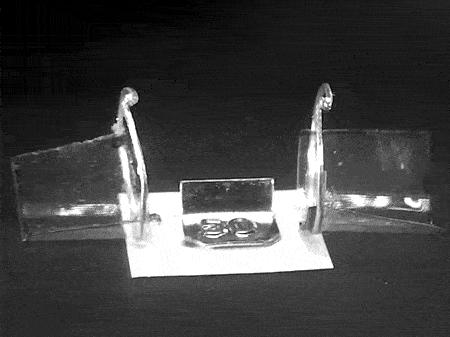Pitt and CMU researchers develop high-torque light-powered actuator

Credit: Mahnoush Babaei
If you watch the leaves of a plant long enough, you may see them shift and turn toward the sunlight through the day. It happens slowly, but surely.
Some man-made materials can mimic this slow but steady reaction to light energy, usually triggered by lasers or focused ambient light. New research from the University of Pittsburgh and Carnegie Mellon University has discovered a way to speed up this effect enough that its performance can compete against electrical and pneumatic systems.
“We wanted to create machines where light is the only source of energy and direction,” explained M. Ravi Shankar, professor of industrial engineering and senior author of the paper. “The challenge is that while we could get some movement and actuation with light-driven polymers, it was too slow of a response to be practical.”
When the polymer sheet is flat, the light animates it slowly, curving or curling over time. The researchers found that by forming the polymer into a curved shape, like a shell, the bending action happened much more quickly and generated more torque.
“If you want to move something, like flip a switch or move a lever, you need something that will react quickly and with enough power,” said Shankar, who holds a secondary appointment in mechanical engineering and materials science. “We found that by applying a mechanical constraint to the material by confining it along on the edges, and embedding judiciously thought-out arrangements of molecules, we can upconvert a slow response into something that is more impulsive.”
The researchers used a photoresponsive azobenzene-functionalized liquid crystalline polymer (ALCP) film that is 50 micrometers thick and several millimeters in width and length. A shell-like geometry was created by confining this material along its edges to create a curve. Shining light on this geometry folds the shell at a crease that spontaneously nucleates. This folding occurs within tens of milliseconds and generates torque densities of up to 10 newton-meters per kilogram (10Nm/kg). The light driven response is magnified by about three orders-of-magnitude in comparison to the material that was flat.
“The outcomes of the project are very exciting because it means that we can create light powered actuators that are competitive with electrical actuators,” said Kaushik Dayal, coauthor and professor of civil and environmental engineering at CMU.
“Our approach towards scaling up the performance of light-driven polymers could reinvent the design of fully untethered soft robots with numerous technological applications,” added lead author and post-doctoral researcher at CMU Mahnoush Babaei.
###
The paper, “Torque-dense Photomechanical Actuation,” (DOI: 10.1039/D0SM01352H) was published in the journal Soft Matter.
Media Contact
Maggie Pavlick
[email protected]
Original Source
https:/
Related Journal Article
http://dx.




